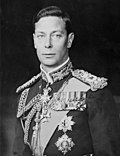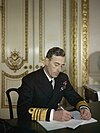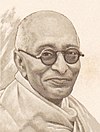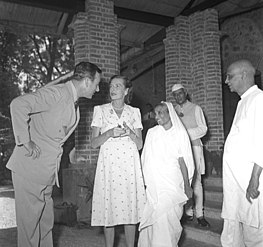Dominion of India
Union of India | |||||||||
|---|---|---|---|---|---|---|---|---|---|
| 1947–1950 | |||||||||
| Capital | New Delhi | ||||||||
| Government | Federal parliamentary constitutional monarchy | ||||||||
| King | |||||||||
• 1947–1950 | George VI | ||||||||
| Governor-General | |||||||||
• 1947–1948 | Louis Mountbatten | ||||||||
• 1948–1950 | Chakravarti Rajagopalachari | ||||||||
| Prime Minister | |||||||||
• 1947–1950 | Jawaharlal Nehru[2] | ||||||||
| Legislature | Constituent Assembly | ||||||||
| History | |||||||||
| 15 August 1947 | |||||||||
| 26 January 1950 | |||||||||
| Area | |||||||||
| 1950 | 3,287,263 km2 (1,269,219 sq mi) | ||||||||
| Currency | Indian rupee | ||||||||
| |||||||||
| Today part of | |||||||||
The Union of India,[3] also called the Dominion of India, was an independent dominion in the British Commonwealth of Nations between 15 August 1947 and 26 January 1950. It was created by the Indian Independence Act 1947 and was transformed into the Republic of India by the promulgation of the Constitution of India in 1950.[4]
George VI was king of India throughout and was represented by the Governor-General of India. However, the Governor-General was not designated Viceroy, as had been customary under the British Raj. The office of Viceroy was abolished on independence. Two governors-general held office between independence and India's transformation into a republic: Louis Mountbatten, 1st Earl Mountbatten of Burma (1947–48) and Chakravarti Rajagopalachari (1948–50). Jawaharlal Nehru was Prime Minister of India throughout.
Formation
Since the late 1920s the Indian independence movement had been demanding Pūrṇa Swarāj (complete self-rule) for the Indian nation and the establishment of the Dominion of India and the Dominion of Pakistan was a major victory for the Swarajis. Nevertheless, the Partition was controversial among the people, and resulted in significant political instability and displacement.[5]
The 1946 Cabinet Mission to India proposed 'Union of India' as a political unit that would encompass both British India and the Indian princely states.[6] The Mission's plan did not come into fruition due to disagreements over the powers to be held by the Union government. On 3 June 1947, it was decided that British India would be partitioned into two sovereign states, both dominions: Pakistan, consisting of Muslim-majority regions, and India, consisting of the rest. In deference to the wishes of Indian National Congress, it was accepted that the partition would be regarded as the Muslim majority areas splitting off from India.[7]
The Partition of India took place on 15 August 1947,[8] leading to the creation of Pakistan (which later split into the Islamic Republic of Pakistan and the People's Republic of Bangladesh in 1971) and India.
Most of the 565[9] princely states within Indian territory acceded to the Dominion of India. The Hindu-majority Junagadh State located in modern-day Gujarat attempted to accede to Pakistan under Nawab Sir Muhammad Mahabat Khanji III, who was a Muslim. It was annexed militarily by the Indian government. Similarly, the State of Hyderabad sought to remain independent and was also annexed by India in 1948.[5]
History
The newly created states of Pakistan and India both joined the Commonwealth, a platform for cooperation between the countries that had been part of the British Empire. Nevertheless, they soon found themselves at war that began in October 1947, over the contested princely state of Jammu and Kashmir. Pakistani militants entered the state, alarming Maharaja Hari Singh who appealed to India for military intervention, in exchange for the signing of the Instrument of Accession and annexation into India. The region is contested to this day, and two other Indo-Pakistan wars occurred as part of the Kashmir conflict.[5]
Reign of George VI

Under the Indian Independence Act 1947, British India was to be divided into the independent sovereign states of India and Pakistan.[11] From 1947 to 1950, George VI was the sovereign of India, which shared the same person as its sovereign with the United Kingdom and the other Dominions in the British Commonwealth of Nations.[3][12][13][14][15] The monarch's constitutional roles were mostly carried out by the Governor-General of India.[12]
Following India's independence, King George VI continued to confer awards and honours in the Dominion of India in his name. Most of them were awarded on the advice of "His Majesty's Indian Ministers".[16][17][18]
On 28 April 1948, the Prime Minister of the Dominion of India, Jawaharlal Nehru advised King George VI that Chakravarty Rajagopalachari should succeed Lord Mountbatten as the next Governor-General of India. The proposal read:[19]
JAWAHARLAL NEHRU presents his humble duty to Your Majesty and has the honour to submit, for Your Majesty's approval, the proposal of Your Majesty's ministers in the Dominion of India that Sri Chakravarty Rajagopalachari, Governor of West Bengal, be appointed to be the Governor General of India on the demission of that office by His Excellency Real Admiral the Earl Mountbatten of Burma, K.G., P.C., G.M.I.E., G.C.V.O., K.C.B., D.S.O.
- Jawaharlal Nehru
- PRIME MINISTER OF THE DOMINION OF INDIA
Rajagopalachari was appointed following the resignation of Lord Mountbatten on 21 June 1948.[19][20]
On 22 June 1948, King George VI and Queen Elizabeth abandoned the titles King-Emperor and Queen-Empress.[22] The Indian Cabinet desired the country to become a republic, but not to leave the Commonwealth as a consequence of no longer having George VI as king, as happened to Ireland. The issue came to a head in April 1949 at a Commonwealth prime ministers' meeting in London. Under the London Declaration, devised by Canadian prime minister Louis St. Laurent, India agreed that, when it became a republic in January 1950, it would remain in the Commonwealth and accept the British Sovereign as a "symbol of the free association of its independent member nations and as such the Head of the Commonwealth". Upon hearing this, George VI told the Indian politician Krishna Menon: "So, I've become 'as such'".[23]
The monarchy was abolished on 26 January 1950, when India adopted a new constitution and became a republic within the Commonwealth, the first Commonwealth country to do so.[24][25]
On 6 February 1952, Nehru announced the death of King George VI in Parliament, a few minutes after the news had reached Delhi that afternoon. He said that the news of the King's death had come as a "surprise and shock". Addressing the House of the People, he said, in part:[26][27][28]
Whatever the views of persons may be here or elsewhere on the question of royalty and republicanism, each country decides for itself; we decided in favour of a republic and we are the Republic of India but it is a significant thing in this world of Republics how the British Royal House has stood firm, firm not in law merely, but firm in the affection of the people of the United Kingdom.
After the speech, the Speaker of the House sent a telegram to George's widow, Queen Elizabeth, in which he conveyed India's "deep sorrow". It was announced that Parliament will not meet the next day in view of the King's death.[26][29]
As the position of the Head of the Commonwealth was non-hereditary, Elizabeth II's succession to that role needed to be endorsed by all the nations of the Commonwealth, and by India in particular. This diplomatic uncertainty was clarified on 8 February 1952, when Nehru sent a message of condolence to the new monarch, Elizabeth II, which said:[30][31]
May I welcome Your Majesty as the new Head of the Commonwealth and earnestly trust that this great fellowship will continue to work for the cause of human understanding and peace throughout the world.
The other nations of the Commonwealth also recognised the new Queen as the new Head of the Commonwealth. The next year, Queen Elizabeth II became the first monarch to have "Head of the Commonwealth" included in her official title.[30]
Norman Hartnell, the designer of the Queen's Coronation gown had embroidered it with the floral emblems of each Commonwealth nation. He included the lotus flower for India.[30] Jawaharlal Nehru and his daughter Indira Gandhi also attended the Coronation of the Queen at Westminster Abbey on 2 June 1953, where they also took part in the carriage procession.[32]
List of heads of state
From 1947 to 1950 the head of state of India was the same person as the Monarch of the United Kingdom, who was represented in India, under the Indian Independence Act 1947, by a Governor-General, who exercised the duties of the head of state.
Monarch
| Portrait | Name | Birth | Reign | Death | Consort | Relationship with Predecessor(s) | Royal House |
|---|---|---|---|---|---|---|---|

|
George VI | 14 December 1895 | 15 August 1947 – 26 January 1950 |
6 February 1952 | Queen Elizabeth | None (position created). Emperor of India before partition. | Windsor |
Governors-General
| Portrait | Name (birth–death) |
Took office | Left office | Appointer |
|---|---|---|---|---|

|
The Viscount Mountbatten of Burma[33] (1900–1979) |
15 August 1947 | 21 June 1948 | George VI |

|
Chakravarti Rajagopalachari (1878–1972) |
21 June 1948 | 26 January 1950 |
List of prime ministers
| Portrait | Name (birth–death); constituency |
Party (Alliance) |
Term of office[34] | Elections (Lok Sabha) |
Council of Ministers |
Appointed by | |
|---|---|---|---|---|---|---|---|

|
Jawaharlal Nehru (1889–1964) MP for Phulpur |
style="background:Template:Indian National Congress/meta/color;" | Indian National Congress | 15 August 1947 |
26 January 1950 |
— | Nehru I | Lord Mountbatten |
Gallery
-
Lord Mountbatten swearing in Jawaharlal Nehru as the first Prime Minister of the Dominion of India on 15 August 1947
-
Jawaharlal Nehru delivering his 'Tryst with Destiny' speech at Parliament House in New Delhi during the midnight session of the Constituent Assembly on 14-15 August 1947
-
Lord Mountbatten, the Governor-General of the new Dominion of India, addressing the Independence Day session of the Constituent Assembly on 15 August 1947
-
Following independence in 1947, George VI banknote series continued to be legal tender till 1950 when post-independence notes were issued.[35]
-
Emergency trains crowded with desperate refugees following the Partition of the British Indian Empire
-
Mahatma Gandhi's funeral procession in February 1948
-
Earl and Countess Mountbatten bidding farewell to Sardar Patel and Maniben Patel in Dehra Dun on 13 June 1948
-
Rajendra Prasad shaking hands with Jawaharlal Nehru after signing the Constitution in 1950
Notes
- ^ See territorial exchanges between India and Bangladesh (India–Bangladesh enclaves).
- ^ See Sino-Indian War of 1962.
| History of India |
|---|
 |
| Timeline |
References
- ^ "Press Communique' - State Emblem" (PDF). Press Information Bureau of India - Archive. Archived (PDF) from the original on 24 February 2018.
{{cite web}}:|archive-date=/|archive-url=timestamp mismatch; 8 August 2017 suggested (help) - ^ As Prime Minister of India until 1964.
- ^ a b *Winegard, Timothy C. (2011), Indigenous Peoples of the British Dominions and the First World War, Cambridge University Press, p. 2, ISBN 978-1-107-01493-0 Quote: “The first collective use (of the word "dominion") occurred at the Colonial Conference (April to May 1907) when the title was conferred upon Canada and Australia. New Zealand and Newfoundland were afforded the designation in September of that same year, followed by South Africa in 1910. These were the only British possessions recognized as Dominions at the outbreak of war. In 1922, the Irish Free State was given Dominion status, followed by the short-lived inclusion of India and Pakistan in 1947 (although India was officially recognized as the Union of India). The Union of India became the Republic of India in 1950, while the became the Islamic Republic of Pakistan in 1956.”
- ^ Winegard, Timothy C. (2011), Indigenous Peoples of the British Dominions and the First World War, Cambridge University Press, pp. 2–, ISBN 978-1-107-01493-0
- ^ a b c India: A History. New York, USA: Grove Press. 2000. ISBN 978-0-8021-3797-5.
- ^ Menon, Vapal Pangunni (2015), Transfer of Power in India, Princeton University Press, p. 264, ISBN 978-1-4008-7937-3
- ^ Pande, Aparna (2011), Explaining Pakistan’s Foreign Policy: Escaping India, Routledge, p. 178, note 52, ISBN 978-1-136-81894-3
- ^ Section 1 of the Indian Independence Act, 1947
- ^ "Indian Princely States before 1947 A-J".
- ^ "Republic India Coinage". Reserve Bank Of India. Retrieved 9 May 2021.
India won its independence on 15th August, 1947. During the period of transition India retained the monetary system and the currency and coinage of the earlier period and introduced a new distinctive series of coins on 15th August, 1950. ...[The Anna Series] was introduced on 15th August, 1950 and represented the first coinage of Republic India. The King's Portrait was replaced by the Lion Capital of the Ashoka Pillar.
- ^ Matthew, H. C. G. (September 2004). "George VI". Oxford Dictionary of National Biography (online ed.). Oxford University Press. doi:10.1093/ref:odnb/33370. Retrieved 20 April 2008.
India and Pakistan remained among the king's dominions but both were set on republican courses, becoming republics within the Commonwealth in 1950 and 1956 respectively.
(Subscription or UK public library membership required.) - ^ a b Kumarasingham, Harshan (2013), THE 'TROPICAL DOMINIONS': THE APPEAL OF DOMINION STATUS IN THE DECOLONISATION OF INDIA, PAKISTAN AND CEYLON, vol. 23, Transactions of the Royal Historical Society, p. 223,
Few today, including those who work on the subcontinent, recollect that India, Pakistan and Sri Lanka did not become republics the day British rule ended. Even distinguished scholars of Empire like Perry Anderson and A. G. Hopkins have made the common assumption that India naturally became a republic upon independence on 15 August 1947. Instead, all three of these South Asian states began their independent life as Realms within the British Commonwealth and mirrored the style and institutions of the Dominions of Canada, Australia, South Africa and New Zealand. Though their sovereignty was in no way impaired by this seemingly ambiguous position they all held the British sovereign as their head of state who was represented in each capital by a governor- general appointed on the advice of the local prime minister. India, Pakistan and Ceylon were Realms from 1947 to 1950, 1947 to 1956 and 1948 to 1972 respectively.
- ^ Panickar, Sreejith (15 August 2015). "Why August 15 should not be Independence Day". DailyO. Retrieved 26 February 2021.
- ^ Daniyal, Shoaib (15 August 2015). "Five things you didn't know about India's Independence Day". Scroll.in. Retrieved 26 February 2021.
- ^ "Did India really achieve freedom in 1947?". Deccan Herald. 15 August 2020. Retrieved 26 February 2021.
- ^ "No. 38313". The London Gazette (3rd supplement). 4 June 1948. p. 3401.
- ^ "No. 38630". The London Gazette (3rd supplement). 3 June 1949. p. 2833.
- ^ "No. 38799". The London Gazette (3rd supplement). 30 December 1949. p. 39.
- ^ a b "Reminiscences of the Nehru Age", M. O. Mathai, Vikas Publishing House, p. 22, 1978, ISBN 9781578660667
- ^ Facts on File: Volume 8, Facts on File News Services, 1948, p. 146
- ^ Treaty of Friendship & Establishment, Ministry of External Affairs, Government of India, 14 August 1948, archived from the original on 9 May 2021, retrieved 31 May 2021
- ^ Townsend, Peter (1975). The Last Emperor. London: Weidenfeld and Nicolson. ISBN 978-0-297-77031-2.
- ^ "Staying loyal to George". indianexpress.com.
- ^ Winegard, Timothy C. (2011), Indigenous Peoples of the British Dominions and the First World War, Cambridge University Press, pp. 2–, ISBN 978-1-107-01493-0
- ^ Beg, Sahil M (15 August 2020). "For dominion India, real independence did not come in 1947". The Indian Express. Retrieved 26 February 2021.
- ^ a b PRIME MINISTER EXPRESSES DEEP SORROW ON DEATH OF KING GEORGE VI (PDF), Press Information Bureau Archives, 6 February 1952, archived from the original (PDF) on 29 May 2021, retrieved 31 May 2021
- ^ "Selected Works of Jawaharlal Nehru: Second series · Volume 17", Jawaharlal Nehru, S. Gopal, Madhavan K. Palat, Jawaharlal Nehru Memorial Fund, p. 500, 1984
- ^ Journal of the Parliaments of the Commonwealth: Volume 33, United Kingdom Branch of the Commonwealth Parliamentary Association, 1952, p. 146
- ^ "The New York Times Great Stories of the Century: The Major Events of the 20th Century as Reported in the Pages of the New York Times", New York Times, Galahad Books, p. 107, 1999, ISBN 9781578660667
- ^ a b c Hardman, Robert (2018), Queen of the World, Random House, ISBN 9781473549647
- ^ Select Documents on the Constitutional History of the British Empire and Commonwealth: The dominions and India since 1900, Greenwood Press, 1985, p. 183
- ^ "No. 40020". The London Gazette (11th supplement). 17 November 1953. p. 6224.
- ^ Created Earl Mountbatten of Burma on 28 October 1947.
- ^ "Former Prime Ministers". PM India. Retrieved 2 January 2015.
- ^ "British India Issues". Reserve Bank Of India. Retrieved 13 May 2021.
The George VI series continued till 1947 and thereafter as a frozen series till 1950 when post independence notes were issued.
- Use dmy dates from May 2013
- 1947 establishments in India
- 1950 disestablishments in India
- Former Commonwealth realms
- Former countries in South Asia
- Former polities of the Cold War
- Government of India
- History of the Republic of India
- India and the Commonwealth of Nations
- India–United Kingdom relations
- Political history of India
- States and territories established in 1947
- States and territories disestablished in 1950


![Emblem [1] of India](http://upload.wikimedia.org/wikipedia/commons/thumb/d/db/Emblem_of_India_%28without_motto%29.svg/60px-Emblem_of_India_%28without_motto%29.svg.png)





![Following independence in 1947, George VI banknote series continued to be legal tender till 1950 when post-independence notes were issued.[35]](http://upload.wikimedia.org/wikipedia/commons/thumb/d/da/KGVI_rupees_5_note_cdd_front_obverse.jpg/432px-KGVI_rupees_5_note_cdd_front_obverse.jpg)



